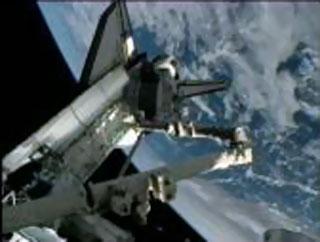
Thermal infrared images of Saturn from the Very Large Telescope Imager and Spectrometer for the mid-Infrared (VISIR) instrument on the European Southern Observatory's Very Large Telescope, on Cerro Paranal, Chile, appear at center and on the right. Photo: ESO/Univ. of Oxford/T. Barry.
PASADENA, CALIFORNIA (BNS): NASA's Cassini spacecraft and a European Southern Observatory ground-based telescope tracked the growth of a giant early-spring storm in Saturn's northern hemisphere that is so powerful it stretches around the entire planet.
The rare storm has been wreaking havoc for months and shooting plumes of gas high into the planet's atmosphere.
This is the first major storm on Saturn observed by an orbiting spacecraft and studied at thermal infrared wavelengths, where Saturn's heat energy reveals atmospheric temperatures, winds and composition within the disturbance.
According to a NASA news report, Cassini's radio and plasma wave science instrument first detected the large disturbance, and amateur astronomers tracked its emergence in December 2010.
The storm produced a 3,000-mile-wide (5,000-kilometer-wide) dark vortex, possibly similar to Jupiter's Great Red Spot, within the turbulent atmosphere.
"Nothing on Earth comes close to this powerful storm. A storm like this is rare. This is only the sixth one to be recorded since 1876, and the last was way back in 1990," Leigh Fletcher, the study's lead author and a Cassini team scientist at the University of Oxford in the United Kingdom, was quoted as saying in the NASA report.
Temperature data were provided by the Very Large Telescope (VLT) on Cerro Paranal in Chile and Cassini's composite infrared spectrometer (CIRS), operated by NASA's Goddard Space Flight Center in Greenbelt, Maryland.
"Our new observations show that the storm had a major effect on the atmosphere, transporting energy and material over great distances, modifying the atmospheric winds -- creating meandering jet streams and forming giant vortices -- and disrupting Saturn's slow seasonal evolution," added Glenn Orton, a paper co-author, based at NASA's Jet Propulsion Laboratory in Pasadena.
The storm may have originated deep down in the water clouds where a phenomenon similar to a thunderstorm created a giant convective plume of gas that headed upwards and punched through Saturn's usually serene upper atmosphere, astronomers said.
 Previous Article
Previous Article Next Article
Next Article












The Indian Air Force, in its flight trials evaluation report submitted before the Defence Ministry l..
view articleAn insight into the Medium Multi-Role Combat Aircraft competition...
view articleSky enthusiasts can now spot the International Space Station (ISS) commanded by Indian-American astr..
view article